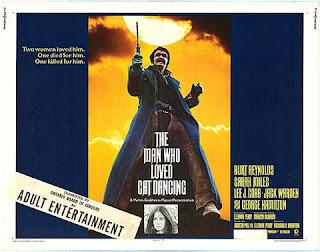
The production of 1973’s The Man Who loved Cat Dancing was rocked by a major scandal. After spending the evening of February 10th with members of the cast and crew, all of whom had gone out to celebrate star Burt Reynolds’ birthday, co-star Sarah Miles returned to her hotel room, where her personal assistant / lover David Whiting was waiting for her.
Bitter that he wasn’t invited and convinced she was having an affair with Reynolds, Whiting instigated an argument with Miles, and, according to reports, struck her several times. Injured, Miles rushed off to Reynolds’ room, who, seeing the condition she was in, allegedly went to have a “chat” with David Whiting.
The next morning, Whiting’s lifeless body was found lying in a pool of blood. The official cause of death would be listed as a drug overdose, with the consensus being that Whiting fell into a table before dying (thus all the blood). But some investigators on the scene felt that didn’t add up, and the pill bottles strewn across the room may have been planted there after the fact. According to one law enforcement official who was part of the initial investigation, "It appears, from the crime scene, Reynolds arrived at the room and had a brief scuffle with Mr. Whiting, a scuffle that turned deadly. All the signs point to Reynolds being involved."
MGM, the studio financing the film, fought to keep both Miles and Reynolds from testifying at the inquest, claiming it would cost them a small fortune if production was delayed any further. Did MGM initiate a cover-up to protect their star? Was Burt Reynolds responsible for the death of David Whiting? Seeing as nearly 50 years have passed - as has Burt Reynolds - we may never know the truth.
But as tragic as this event was, it’s equally sad that it has tarnished what is an otherwise superb motion picture, a well-paced, beautifully shot western / romance that features strong performances by Reynolds, Miles, and, indeed, the entire supporting cast.
As the movie opens, Jay Grobart (Reynolds), a former army captain, is about to rob a train carrying $100,000 in cash. With the help of his gang: Dawes (Jack Warden), Billy Bowen (Bo Hopkins), and a native American named Charlie Bent (Jay Varela), the hold-up is a success. But there’s one small hitch: socialite Catherine Crocker (Miles), who was running away from her wealthy, domineering husband Willard (George Hamilton), witnessed the entire robbery.
Not willing to take chances, Grobart and the others kidnap Catherine and bring her along as they attempt to outrun railroad detective Harvey Lapchance (Lee J. Cobb) and his posse, who are hot on their trail. Joined by Willard Crocker, who is anxious to retrieve his wife, Lapchance and his team tirelessly pursue the thieves, knowing full well where Grobart is heading, and what he intends to do with his share of the money.
To further complicate matters, Catherine finds herself falling in love with Grobart. She is hoping beyond hope that he will somehow evade capture, and the two of them will live happily ever after.
Despite its story of a gang of train robbers on the run, The Man Who Loved Cat Dancing has an almost lyrical quality to it, a somber, even poetic feel that director Richard C. Sarafian maintains through much of the movie. Even when events threaten to turn violent, like when Billy tries to rape Catherine, or Grobart and Dawes face off against one another, the film maintains its solemn tone.
Part of the reason this approach works is the character of Jay Grobart, played so well by Burt Reynolds. Despite being a thief, Grobart has a set of principles he lives by, and when his cohorts get out of line, he is there to “correct” them; he does what he can to keep Catherine safe during their getaway. Matching Reynolds every step of the way is Sarah Miles, whose Catherine is also on the run. Their chemistry is tangible, and the eventual romance that develops between the two seems a foregone conclusion.
Warden is also good as the loathesome Dawes, while Bo Hopkins manages to both piss us off and garner our sympathy as the story unfolds. Toss in the amazing cinematography of Harry Stradling Jr., who makes the most of the film’s picturesque locales (it was shot on-location in Utah and Arizona), and you have a movie that is every bit as beautiful as it is engaging.
Alas, with all the controversy surrounding it, The Man Who Loved Cat Dancing has never garnered the praise or attention it deserves. Even Reynolds himself was reluctant to discuss the movie. “There’s nothing to talk about in Cat Dancing except that it brings me pain”, he would tell critic Gene Siskel during a 1976 interview, adding “So I’d rather not talk about it”.
And that’s a damn shame.
Rating: 9 out of 10
